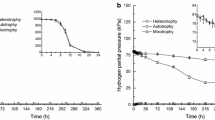Abstract
The evidence, kinetic aspects, and modelization of the inhibitory effect of glycerol on dihydroxyacetone (DHA) production byGluconobacter oxydans have been studied. The comparison of the maximal productivities and specific rates evaluated for initial concentrations of 31, 51, 76, 95, and 129 g L−1 of substrate showed that glycerol exerts an inhibitory effect both on growth and DHA production: decrease of the growth-specific rate and of the specific rate of DHA production with increase of the initial glycerol content. The inhibition phenomenon was attributed to an immediate effect of glycerol on the biological activity. It was also established that the presence of glycerol at high concentration induces an increase in the time necessary for the cells to reach their maximal level of specific rates. This result tends to show that glycerol brings into play on the biological system the capacity to reach its optimal range of activity. The main models found in the literature dealing with substrate inhibition phenomena were then tested on experimental data. The exponential model describes at best the glycerol inhibition on growth (μ=0.53e(−S/93.6)) and on DHA production (qP=7e(−S/76.7)). The kinetic study and modelization of the inhibition effect of glycerol on DHA production allows one, therefore, to fill the gap in the fundamental knowledge of this industrial fermentation, to show the maladjustment of the classical fermentation process used (batch), and to reconsider the conception for the optimization of the production (proposition of more adapted process like fed-batch and/or biphasic systems).
Similar content being viewed by others
Literature Cited
Aldercreutz P (1986) Oxygen supply to immobilized cells: 5. Theorical calculations and experimental data for the oxidation of glycerol by immobilizedGluconobacter oxydans cells with oxygen orp-benziquinone as electron acceptor. Biotechnol Bioeng 28:223–232
Belly RT, Claus GW (1972) Effect of amino acids on the growth ofAcetobacter suboxydans. Arch Microbiol 83:237–243
Blazejak S, Sobcjak E (1988) Bioconversion of glycerol into dihydroxyacetone DHA usingAcetobacter xylinum. Acta Aliment Pol 14:207–216
Bories A, Claret C (1989) Aerobic and anaerobic conversion of glycerol by microorganism. In: Grassi G, Gosse G, de Santos G (eds) Biomass for energy and industry. 5th E. C. Conference. London, New York: Elsevier Applied Science, pp 2.1020–2.1014
Bories A, Claret C, Soucaille P (1991) Kinetic study and optimization of the production of dihydroxyacetone usingGluconobacter oxydans. Proc Biochem 26:243–248
Butlin RB (1938) CLVIII. Enzyme system of Bact. suboxydans. Effect of acids and pH. Biochem J 32:1185–1190
Flickinger MC, Perlman D (1977) Application of oxygen-enriched aeration in the conversion of glycerol to dihydroxyacetone byGluconobacter melanogenus IFO 3293. Appl Environ Microbiol 33:706–712
Fulmer EI, Underkofler LA (1947) Oxidation of polyhydric alcohols byAcetobacter suboxydans. J Sci. 21:251–270
Gossele F, Swings J, De Ley J (1980) Growth factor requirements ofGluconobacter. Zentralbl Bakkteriol Mikrobiol Hyg [B] 1:348–350
Hartmeier W, Heinrichs A (1986) Membrane enclosed alginate beads containingGluconobacter cells and molecular dispersed catalase. Biotechnol Lett 8:567–572
Hauge JG, King TE, Cheldelin VH (1955a) Alternate conversions of glycerol to dihydroxyacetone inAcetobacter suboxydans. J Biol Chem 214:1–9
Hauge JG, King TE, Cheldelin VH (1955b) Oxidation of dihydroxyacetone via the pentose cycle inAcetobacter suboxydans. J Biol Chem 214:11–26
Holst O, Lundback M, Mattiasson B (1985) Hydrogen peroxide as an oxygen source for immobilizedGluconobacter oxydans converting glycerol to dihydroxyacetone. Appl Microbiol Biotechnol 22:383–388
Izuo N, Nabe K, Yamada S, Chibata I (1980) Production of dihydroxyacetone by continuous cultivation ofAcetobacter suboxydans. J Ferment Technol 58:221–226
King TE, Cheldelin VH (1952) Oxidative dissimilation inAcetobacter suboxydans. J Biol Chem 198:127–133
Kustova NA, Pomortseva NV, Krasil'Nikovao TN, Nikolaev PI (1979) Effect of aeration on the synthesis of dihydroxyacetone from glycerol byGluconobacter oxydans. Appl Biochem Microbiol 15:51–56
Luong JHT (1987) Kinetics of ethanol inhibition in alcohol fermentation. Biotechnol Bioeng 29:242–248
Magasanik B, Brooke MS, Karibian D (1953) Metabolic pathways of glycerol dissimilation. J Bacteriol 66:611–619
Makhotkina TA, Pomortseva NV, Lomova IE, Nikolaev PI (1981) Transformation of glycerol into dihydroxyacetone byGluconobacter oxydans cells in a polyacrylamide gel. Appl Biochem Microbiol 17:80–84
Mulchandani A, Luong JHT (1989) Microbial inhibition revisited. Enzyme Microb Technol 11:66–73
Nabe K, Izuo N, Chibata I (1979) Conversion of glycerol to dihydroxyacetone by immobilized whole cells ofAcetobacter xylinum. Appl Environ Microbiol 38:1056–1060
Oostrehuis NMG, Groesberg NM, Kossen NWF, Schenk ES (1985) Influence of dissolved oxygen concentration on the kinetics ofGluconobacter oxydans. Appl Microbiol Biotechnol 21:42–49
Pomortseva NV, Krasil'Nikov TN, Paleeva M, Nikolaev P (1974) Production of dihydroxyacetone by a suspension of restingAcetobacter suboxydans cells. J Appl Biochem Microbiol 10:46–49
Raghavendra Rao MR, Stokes JL (1953) Nutrition of the acetic acid bacteria. J Bacteriol 65:405–412
Rutten AMG (1951) Biochemical production of dihydroxyacetone from glycerol. Rec Trav Chim 70:499–456
Stokes JL, Larsen A (1945) Amino acid requirements ofAcetobacter suboxydans. J Bacteriol 49:495–507
Su YC, Koo K, Yin SL (1989) Studies on the production of 1,3-dihydroxypropanone byGluconobacter oxydans CCRC 10684. J Chinese Agricult Chem Soc 27:307–321
Underkofler LA, Fulmer EI (1937) The production of dihydroxyacetone by the action ofAcetobacter suboxydans upon glycerol. J Am Chem Soc 89:301–302
Underkofler IA, Bantz AC, Peterson WH (1943) Growth factors for bacteria. XIV. Growth requirements ofAcetobacter suboxydans. J Bacteriol 45:183–190
Williams PJ le B, Rainbow C (1964) Enzymes of the tricarboxylic acid cycle in acetic acid bacteria. J Gen Microbiol 35:237–247
Yamada S, Nabe K, Izuo N, Wada M, Chibata I (1979) Fermentative production of dihydroxyacetone byAcetobacter suboxydans ATCC 621. J Ferment Technol 57:215–220
Author information
Authors and Affiliations
Rights and permissions
About this article
Cite this article
Claret, C., Bories, A. & Soucaille, P. Glycerol inhibition of growth and dihydroxyacetone production byGluconobacter oxydans . Current Microbiology 25, 149–155 (1992). https://doi.org/10.1007/BF01571023
Issue Date:
DOI: https://doi.org/10.1007/BF01571023




